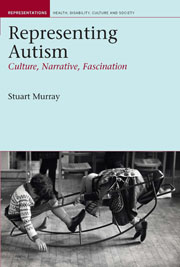Book contents
- Frontmatter
- Contents
- List of figures
- Permissions
- Preface: questions
- Introduction: autism and narrative
- 1 Presences: autistic difference
- 2 Idiots and savants
- 3 Witnessing
- 4 Boys and girls, men and women
- 5 In our time: families and sentiments
- Conclusion: causing/curing/caring
- Acknowledgements
- Select bibliography
- Index
4 - Boys and girls, men and women
- Frontmatter
- Contents
- List of figures
- Permissions
- Preface: questions
- Introduction: autism and narrative
- 1 Presences: autistic difference
- 2 Idiots and savants
- 3 Witnessing
- 4 Boys and girls, men and women
- 5 In our time: families and sentiments
- Conclusion: causing/curing/caring
- Acknowledgements
- Select bibliography
- Index
Summary
There is a swirl of comment and debate about the causes, manifestations and treatments of autism, but in the midst of the various arguments it is wise to remember that it is properly understood at a general level as being a lifelong condition. ‘Autism’, Uta Frith noted in Autism: Explaining the Enigma in 1989, ‘does not go away’. It is, in the more technical language of Laura Schreibman, a ‘form of psychopathology … characterized by a unique constellation of severe and pervasive behavioural deficits and excesses’ (emphasis added). Pervasive and present, autism is not something one grows out of. And yet, given that this is the case, contemporary cultural fascination with autism nevertheless relentlessly focuses on the figure of the child when seeking to explore what autism is and what it might mean. Neurologist Carl H. Delacato titled his 1984 study of children with autism The Ultimate Stranger: The Autistic Child, and this overlapping of autism and the child as some ‘ultimate’ form of the condition is typical of discourses on the subject. Even though it is obvious that children with autism will become adults with autism, the sense that the condition somehow affects children more than adults is itself pervasive. Again and again in contemporary cultural narratives it is the child who carries the weight of what we wish to say or think about the condition, and it is through a focus on children that autism is increasingly being understood.
- Type
- Chapter
- Information
- Representing AutismCulture, Narrative, Fascination, pp. 139 - 167Publisher: Liverpool University PressPrint publication year: 2008

